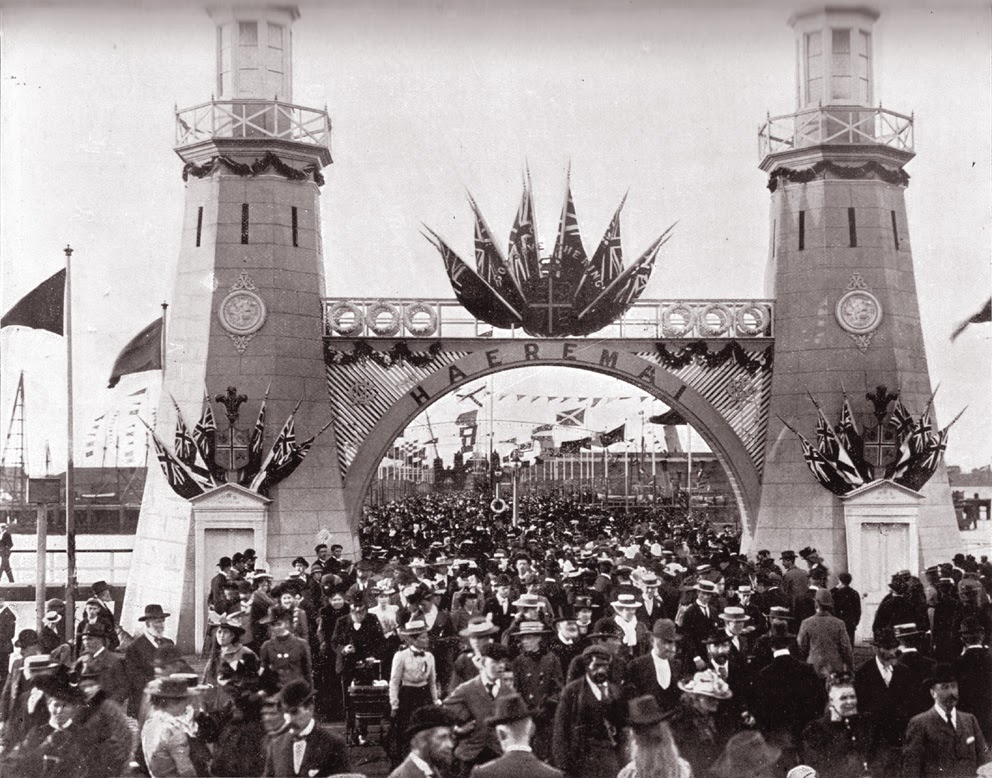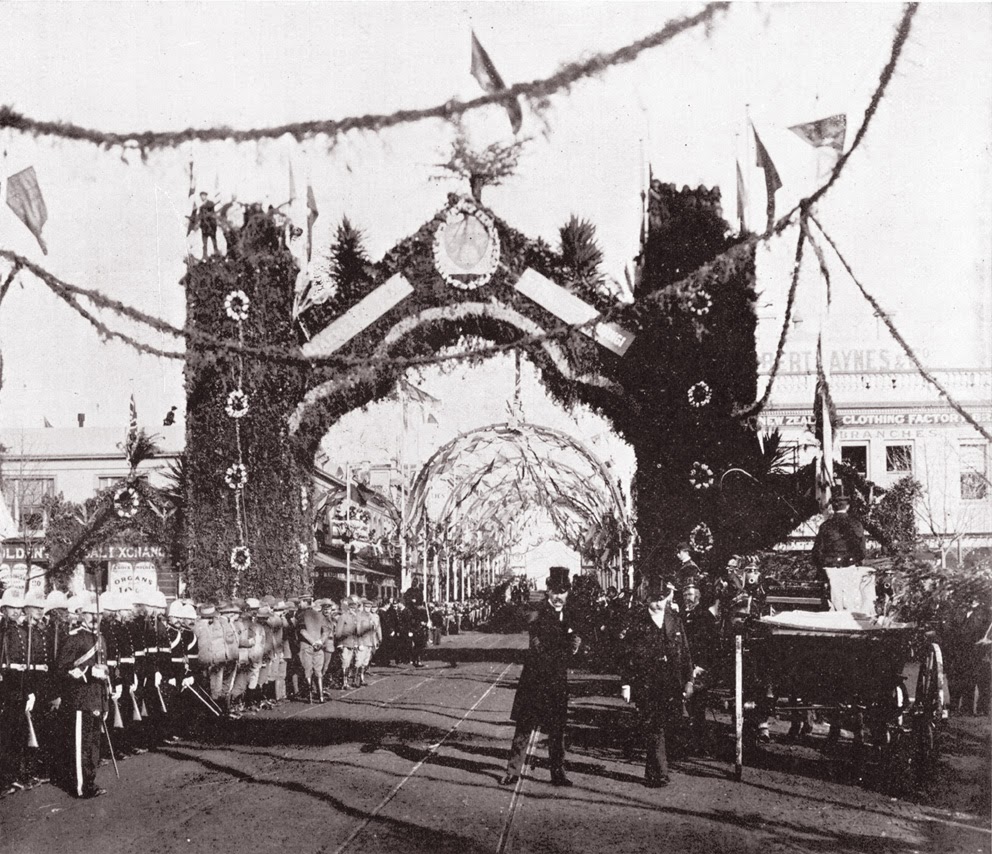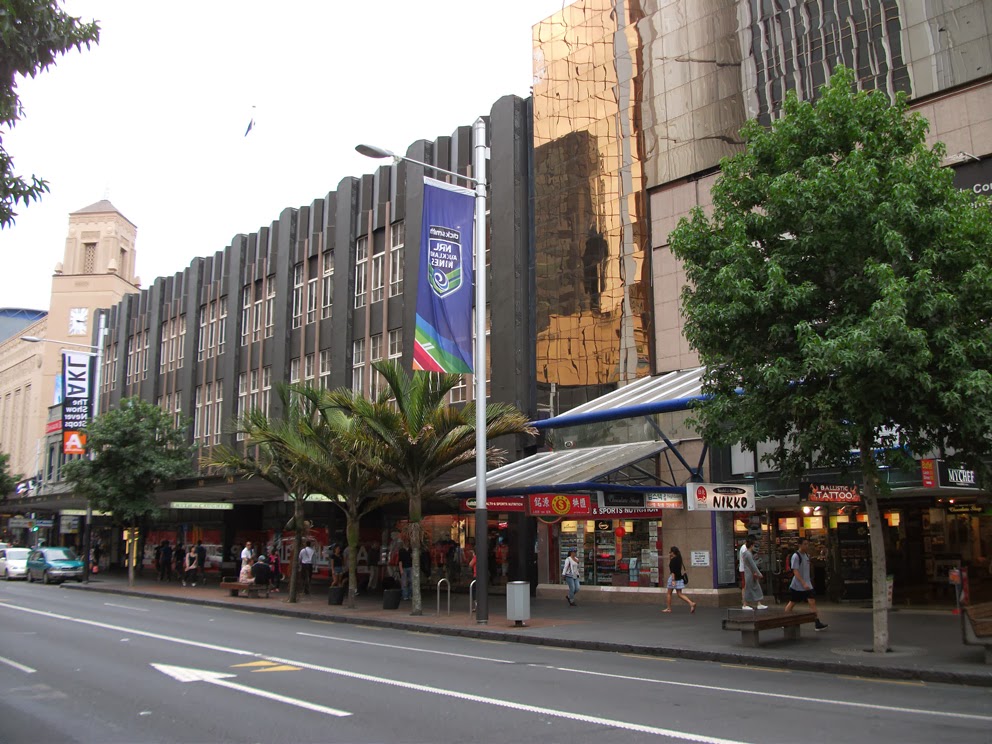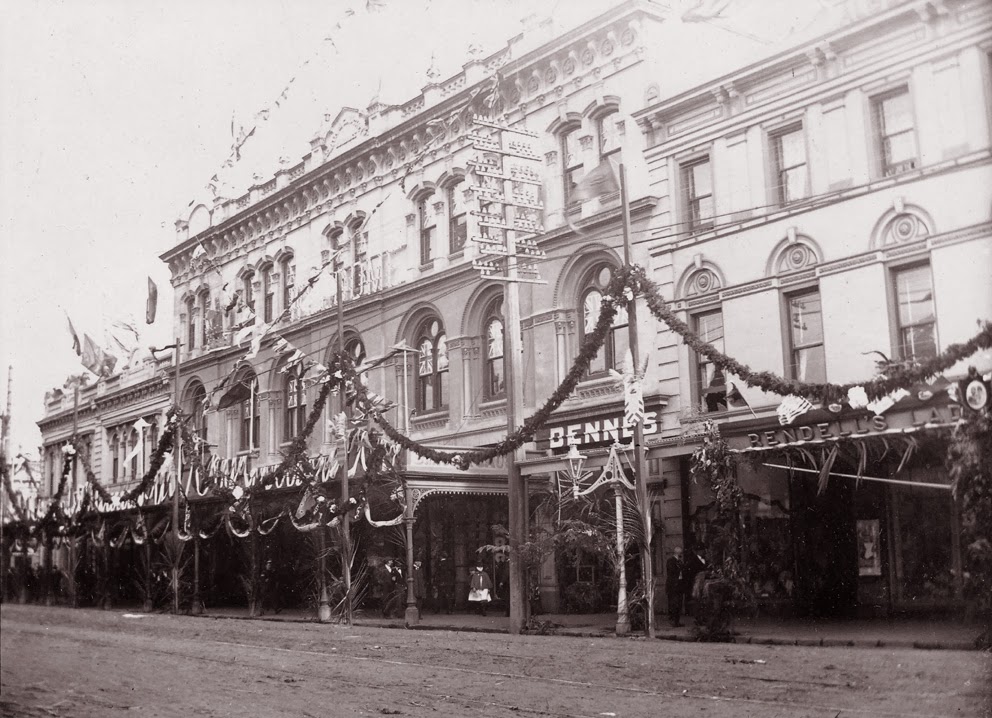The Dominion of New Zealand will be hosting Prince William, Duke of Cambridge together with his wife, Catherine Duchess of Cambridge, and their young son Prince George to New Zealand from the 7th April to the 16th April 2014. This provides an opportunity to look back at an interesting aspect of past Royal Tours - the Ceremonial Arch. In this Blog we specifically look at the visit to New Zealand of Prince William's Great Great Grandfather, HRH Prince George, Duke of Cornwall & York and his wife, HRH Princess Mary, Duchess of Cornwall & York (later King George V and Queen Mary) in June 1901.
Perhaps understandably due to their cost and very temporary nature, ceremonial and full floral arches are now a thing of the past. While many look very solid, they were generally nothing more than wood, painted canvas, and/or moulded plaster over a wire frame in the manner of stage scenery. That they did not find other uses elsewhere would also prove this point.
Auckland Arches
 |
| The Auckland Harbour Board Arch on the Queen Street Wharf comprised of two light houses connected by a Roman arch. [Source : "Royalty in New Zealand", 1901] |
The construction of ceremonial arches had in fact a long history going back to Medieval England but had even earlier European origins in both Renaissance Italy and early France. By passing through an Arch, a guest would be acknowledged as an honoured and respected friend or ally, perhaps in the manner of an honoured visitor now being given the "keys" to a city.
Temporary ceremonial Arches are in fact known to have been hastily constructed in ancient Rome to provide a symbolic "Triumphal Arch" through which a victorious army and Generals could march through, often later being replaced with permanent structures to honour their victory.
But it appears evident that by the Victorian era it would not be the done thing for a Government or local body or organisation not to be represented in this way and i'm sure there was often an element of good-natured one-upmanship involved, in other words, not to be seen to be outdone by others. And of course, nobody but nobody would want the Royal visitors to think that New Zealand's welcome was inferior to that of any other country. But the expense appears to have been entirely secondary and in fact the general New Zealand public, who for most had not previously experienced any royal pomp and ceremony first-hand, appear to have revelled in and wholeheartedly embraced this overt display of affection for the Royal couple. That these decorative Arches gave all a demonstrative way to show their loyalty to the Crown and the warmth of their welcome is, I believe, well represented in these images. The only city in these images not represented by a visit by the Duke and Duchess of Cambridge in April 2014 is Rotorua.
Rotorua Arches
 |
| The Māori Floral Arch, Rotorua. "The most handsome of all the arches... for the Royal tour" 'Muir and Moodie Photo' [Source : "Royalty in New Zealand", 1901] |
Wellington Arches
 |
| The Citizens' Arch, Wellington [Source : National Library of New Zealand] |
The Citizens' Arch on Customhouse Quay, Wellington with Hunter Street on the right. The words on the arch read : "Welcome from Pakeha and Maori". Flags, together with the Wellington Coat of Arms, decorate the top of the arch. Taken by James McAllister, June 1901.
 |
| The Māori Arch, Wellington [Source : National Library of New Zealand] |
A group waiting to welcome the Royal visitors at the Māori Arch in Charlotte Street, Wellington, taken 18th June 1901.
"The shape was the front of a runanga house above, supported by floral towers. The gable boards of this were no painted counterfeits. They were priceless Maori carvings, old beyond the category of known dates, supposed to reach back to Moriori times. Grass trees in front and rear on each side of the street suggested forest surroundings, and the inscriptions were "Haere Mai" [meaning "Welcome, enter".] and "Naumai" [meaning "Welcome"]."
The precious carvings were watched day and night, also being insured against fire. A fire hydrant and hose were kept close-by in case of any emergency.
 |
| The Westport Arch, Wellington [Source : National Library of New Zealand] |
"A triple arcading, it was singularly massive, with handsome entablature and cornice, like some old Roman arch of triumph, with commemorative tablets; but instead of bronze, cunningly moulded into historic grouping, coal filled the openings; massive blocks of coal - the same that saved the "Calliope" from the Apia hurricane - and gold medallions on each front told of the western resources..."
The words on the arch read : "Westport's Greeting" and "The coal that saved the Calliope". Taken by James McAllister, June 1901.
 |
| The Cereal Arch, representing Marlborough and Wellington Suburbs [Source : "Royalty in New Zealand", 1901] |
The cereal arch was formed by "piling up sheaves of grain... and adorning them with flowers..."
 |
| The Cuba Street Arch, Wellington [Source : National Library of New Zealand] |
A wooden arch in carved Māori style erected at the corner of Cuba Street and Dixon Street, Wellington. The Māori words "Kia Ora Koutou" are a formal greeting to three or more people.
 |
| The Government Arch, Wellington [Source : National Library of New Zealand] |
The carriage conveying the Duke and Duchess of Cornwall and York passing under the Government Arch on Lambton Quay, Wellington, during their procession through Wellington. The arch was modelled on the design of Balmoral Castle and bore on one side the inscription "God bless the Duke and Duchess" and on the other the Māori equivalent, "Ma Te atua korua e atawhai". Taken 18th June 1901.
 |
| The National Dairy Association's Arch, Wellington [Source : National Library of New Zealand] |
The National Dairy Association's arch on Lambton Quay, Wellington. Taken by James McAllister.
 |
| The Wellington Woolen Manufacturing Company Arch, Wellington [Source : National Library of New Zealand] |
The Wellington Woollen Manufacturing Company Ltd Arch on Jervois Quay, Wellington. It ingeniously reads "See the Warmth of Our Welcome" and included a "tricolour display of bales". Taken June 1901.
 |
| The Chinese Citizens' Arch, Wellington [Source : National Library of New Zealand] |
The Chinese Citizens' Arch on Manners Street, Wellington. Taken by James McAllister.
Christchurch Arches
 |
| The Agricultural Arch, Christchurch [Source : "Royalty in New Zealand", 1901] |
"Rural Canterbury lived here for the nonce in foliage, beeves and muttons and dairy cattle stalled on either side, the fruits of the soil arranged above, guarded by stock-riders : an unusual combination, signifying perhaps typically above-ground the burial below of the hatchet, once so deadly between the shepherd kings and the advancing tillers of the soil. The unity above the tomb of that obsolete weapon produced fruit in words of warmth and loyal welcome."
 |
| The Frozen Meat Arch, Christchurch [Source : "Royalty in New Zealand", 1901] |
"...with its graceful span of ice counterfeited - as a broken piece of some wandering iceberg of the sea - resting on blocks of ice, real, enclosing carcasses dressed for the butcher, also chrysanthemums of delicate hues and handsome form, and bearing words of welcome, well displayed..."
 |
| The Fire Brigade Arch, in Worcester Street, Christchurch [Source : "Royalty in New Zealand", 1901] |
"A graceful concept this arch, just as if a company of firemen, surprised on the march, by the sudden appearance of the Royal party, had hurriedly put together their long ladders, tossed a few flags over them, thrown in a little greenery hastily plucked, and hoisted up a few words of welcome, had taken their places in helmet and tunic, standing at "attention", while the pageant passed by with the clamour of many voices."
 |
| The Government Floral Arches over Victoria Bridge [Source : "Royalty in New Zealand", 1901] |
"The procession started again in the midst of the cheering, the roll of acclamation settled itself once more alongside the Duke and Duchess as they moved with their powerful escort had converted the Victoria Bridge down Victoria Street, under the Government Arch. This had converted Victoria Bridge into a tunnel of foliage and flower, and it was beautifully reflected in the smooth water of the Avon below..".
Dunedin Arches
 |
| The Chinese Arch, Dunedin [Source : "Royalty in New Zealand", 1901] |
"In Princes Street the Chinese Arch rose some 46 ft. over the roadway, two square towers in trellis work flanking, with pointed tops like extinguishers, ornamented with carved boards rising up high on either side; square windows beneath them, just where the latticing connecting the towers and making the arch crosses the street. The whole was a mass of red and yellow, effective, but a little hard, as the primary colours always are in Chinese hands; relieved somewhat by a drapery of red, white, and blue on the lower side of the arch, and thick decoration of greenery at the butts of the towers. "Welcome," the motto on one side, and "Welcome from the Chinese Citizens," the greeting on the other."
 |
| The 'Maypole Arch', in The Exchange, Dunedin [Source : "Royalty in New Zealand", 1901] |
 |
| The Government Arch, Dunedin [Source : "Royalty in New Zealand", 1901] |
"...Inside the Octagon [facing George Street]...., was the Government Arch, large central with two smaller flankers of similar Gothic outline, like the medieval castellated entrance to some great city; two turreted towers dividing the three arches, themselves connected by the battlemented top of the city wall, pierced with Gothic ellipse, carrying the shields of York and Cornwall, and rising in the centre two battlement steps above sky-line to display the Royal crown above the Royal Arms. The tops of the flanking arches rising to centre peaks carried each a flagstaff and standard. The turrets above the towers had each a system of poles and standards, four corners, and a central taller one than the rest; and all the standards were joined into a single scheme by a string of signal-flags, which spelt "Welcome." Like the Government Arch in Wellington, it was a close imitation of the entrance to Balmoral Castle. The letters "E.R." flanks the Royal Arms, and the flankers of the ducal shield are the ducal letters "C.Y." The effect is as of the grey granite of Aberdeen; the ducal shields are red and white, and the crown has the national colours. "Welcome to the Duke and Duchess" faces from one side in large warm colours, and the other looks down the brilliant george Street vista in Maori fashion, "Aroha Tonu, Ake, Ake, Ake," which being rendered into English means "Love unceasing, for ever, and ever, and ever."..."
 |
| The Marine Arch, Dunedin [Source : "Royalty in New Zealand", 1901] |
"...Two turreted towers, connected by an entablature, the broad frieze of which carried a large "Welcome;" the arcading hung with a row of life-buoys inscribed with the names of the Union [Steam Ship Company] fleet. The corners of the towers were softened with greenery, their faces carried the Royal and Ducal monograms with steering-wheels, anchors, propellors, and models of steamboats; above the entablature, lying across the street, was a model of the "Monowai", gay with a full dressing of flags; and on the frieze a great warm Celtic welcome, "Cead Mille Failthe." Various house-flags flew from the turrets; two tall flagpoles carried the Royal Standard and the Union Company's familiar house-flag. The arch, covered with canvas, looked like stone, and ta night was charmingly lighted."
 |
| The Citizens' [Municipal] Arch, The Octagon, Dunedin [Source : "Royalty in New Zealand", 1901] |
"At the Princess Street entrance to the Octagon towered the Municipal Arch - a construction in foilage, two great square towers connected by a leafy arcading with entablature peaks above to the height of 40 ft. above the road-way, and fashioned into triple eiilptic Gothic outline below, conncted to two small arches, with peaked tops, at each side. It carried the city coat of arms on the centre peak of the entablature; pillared wreaths, each a floral setting to the rose of York; monograms, floral emblems everywhere. Cabbage-palms filled the square top of each big tower, a big flag floated from each corner of these, the Royal Standard flew from a tall pole rising from the centre peak, and the two lesser peaks over the smaller arches carried each its pole and standard. The entablatures carried Maori words of welcome, "Haere Mai te Manuhiri Tuarangi," and "He Mata Kanohi He Toto Kawera" - which signify respectively, "Welcome illustrious strangers," and "At sight of you our hearts burn within us." The various outlines in different shades of green, and heads of palm and punga at diverse coigns of vantage, greatly heightened the effect of this fine arch. A small band of Maoris were posted on the top to give voice welcomes at the proper time."
Bibliography / Rārangi Pukapuka :
- Photographs taken by Mr R.A. Cook (from my own collection)
- "Royalty in New Zealand" by R.A. Loughnan, 1902 (from my own collection)
- National Library of New Zealand / Te Puna Mātauranga o Aotearoa






































